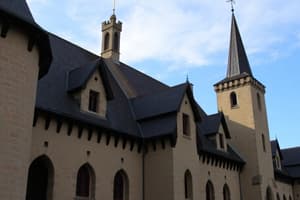Podcast
Questions and Answers
What was the role of the RCC clergy in medieval Europe?
What was the role of the RCC clergy in medieval Europe?
- They had great prestige and moral authority. (correct)
- They enforced laws on serfdom.
- They distributed wealth among the poor.
- They built Gothic cathedrals as a form of worship.
What was the significance of Santiago de Compostela?
What was the significance of Santiago de Compostela?
- It was a natural disaster zone.
- It was the burial site of St. James. (correct)
- It was known for extensive trade routes.
- It served as a military fortress.
Which of the following best describes the social structure of peasants after the Black Death in Western Europe?
Which of the following best describes the social structure of peasants after the Black Death in Western Europe?
- They were forced into permanent serfdom.
- They were taxed heavily without any rights.
- They gained freedom but had to pay lords for various services. (correct)
- Their social status increased dramatically with no obligations.
What common practice helped preserve oral traditions in medieval Europe?
What common practice helped preserve oral traditions in medieval Europe?
What economic system did most peasants in medieval Europe live under?
What economic system did most peasants in medieval Europe live under?
How did the 3 Field System function in agriculture?
How did the 3 Field System function in agriculture?
What was the primary reason for the establishment of the first Jewish ghetto in Venice?
What was the primary reason for the establishment of the first Jewish ghetto in Venice?
What characterized the status of serfdom in Eastern Europe compared to Western Europe by the 1400s?
What characterized the status of serfdom in Eastern Europe compared to Western Europe by the 1400s?
Flashcards
Sacraments and Salvation
Sacraments and Salvation
A belief system prevalent in Medieval Europe that emphasized the importance of sacraments, administered by the Catholic Church, for achieving salvation. This system shaped Europeans' worldview and understanding of the world.
Pilgrimage
Pilgrimage
A journey undertaken by devout Christians to visit a holy site, like the tomb of St. James in Santiago de Compostela, to seek spiritual benefits.
Jewish Ghetto
Jewish Ghetto
Distinct areas within cities where Jewish communities were forced to live, often characterized by restrictions and limitations on their lives.
Nuclear Family
Nuclear Family
Signup and view all the flashcards
Serfdom
Serfdom
Signup and view all the flashcards
Three-Field System
Three-Field System
Signup and view all the flashcards
Common Law
Common Law
Signup and view all the flashcards
Subsistence Economy
Subsistence Economy
Signup and view all the flashcards
Study Notes
Religion and Popular Culture
- Christianity was unifying, shaping beliefs.
- The Catholic Church (RCC) held significant power and moral authority.
- Sacraments were crucial for salvation.
- Religious themes were prominent in art and music.
- Pilgrimages to holy sites were common.
Subsistence Economy
- Land ownership dictated wealth.
- Agriculture was primary, hand-plowed fields.
- Peasants often worked for landlords.
- Some forms of serfdom existed, tying people to the land.
- Seasonal migrations occurred.
- Food sources were basic (bread, vegetables).
- Meat was a luxury.
Magic and Superstition
- "Cunning folk" held some power.
- Superstitions surrounded events and natural occurrences.
Jewish and Muslim Enclaves
- Jewish communities existed in some areas.
- Muslim communities also existed in specific regions of Europe.
- Restrictions and prejudice existed against these groups.
Family Structure
- Nuclear families were more common in Western Europe.
- Extended families were prevalent in other areas.
- Children worked from a young age in some cases.
Social Mobility
- Social classes were rigid.
- The Black Death affected social mobility.
- Some peasants gained freedom from serfdom; others did not.
Crop Production and Agriculture
- The three-field system was a method for crop rotation.
- Land use varied across the region.
- Different crops were common in various regions.
Studying That Suits You
Use AI to generate personalized quizzes and flashcards to suit your learning preferences.
Related Documents
Description
Explore the intertwining of religion, economy, and social structure in medieval Europe. This quiz covers key themes such as the influence of Christianity, subsistence economy, magic, and the coexistence of Jewish and Muslim communities. Test your knowledge of family dynamics and the cultural impact of these elements.




